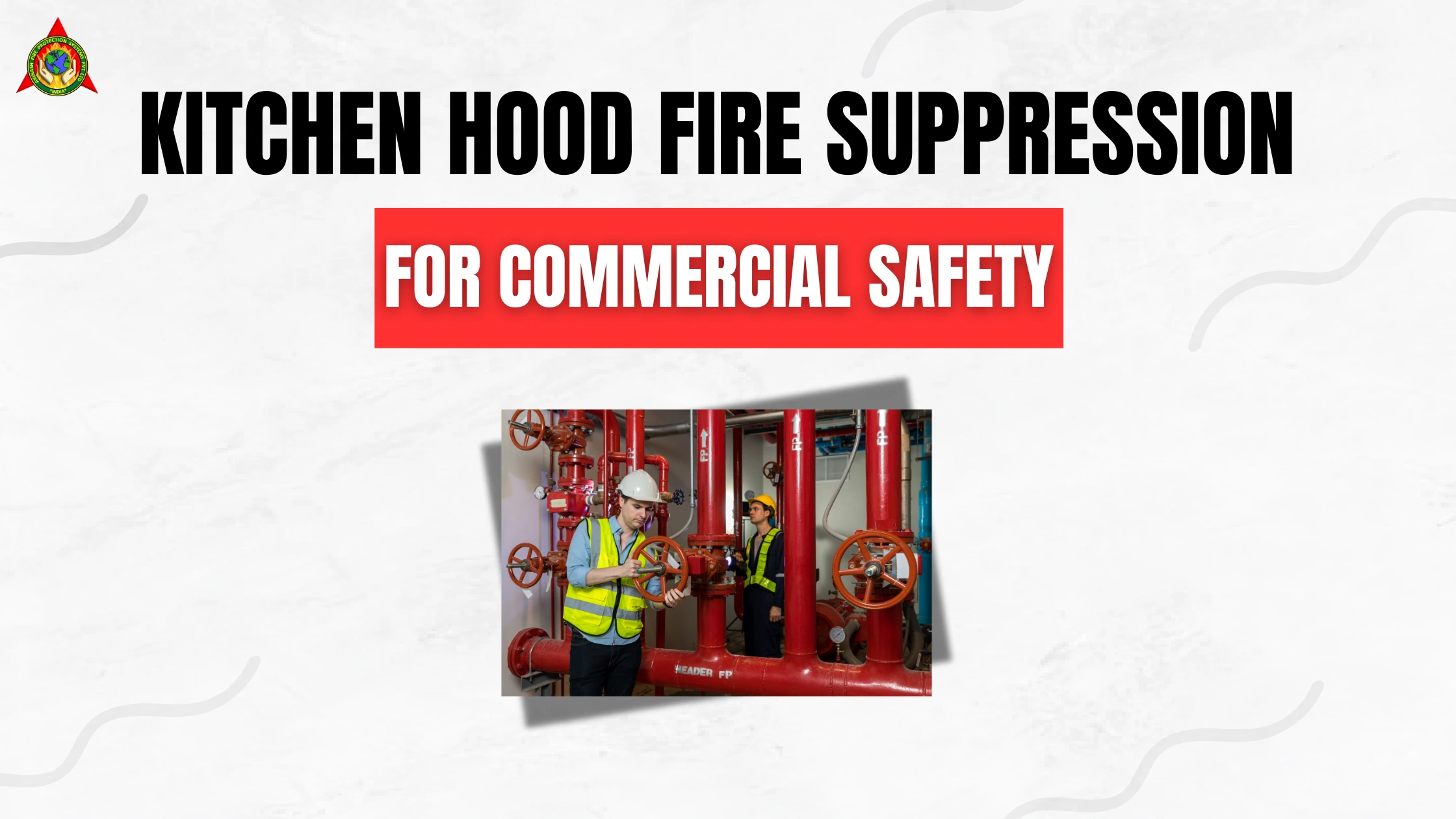Summary
Fire hazards are of considerable concern in commercial kitchens because of the provision and use of heating equipment, flammable oils and electric appliances. A kitchen hood fire suppression system is designed to detect and extinguish fires before they can cause severe damage or injury. An added safety is achieved through incorporation of new technologies such as clean agents and electrical panel-specific suppression. This article explores how these fire suppression systems work, their components, and their vital role in ensuring commercial safety.
Introduction
High-risk areas as regards to fire incidences are commercial kitchens. There is the presence of grease laden vapours, open flames and use of electrical appliances, a perfect ground to become unsafe unless properly controlled. A kitchen hood fire suppression system plays a critical role in controlling and extinguishing fires at the earliest stage. To enhance protection, systems like the clean agent fire suppression system and those built for electrical components are also being widely used.
Kitchen Hood Fire Suppression System
A kitchen hood fire suppression system is installed within the hood and ductwork of commercial kitchen ventilation systems. Its primary job is to automatically detect and suppress fires that occur on cooking surfaces. These systems are typically activated by heat sensors and discharge a wet chemical agent that cools the flames and forms a barrier to prevent re-ignition. Regular maintenance and inspections are crucial to ensure they function effectively in emergencies.
How It Works
A kitchen hood fire suppression system is installed within the hood and ductwork of commercial kitchen ventilation systems. Its major work is automatically identifying and rebelling fires that arise in cooking platforms. They normally operate on heat sensors and release a wet chemical that cools down the fire and creates a blanket to allow re- ignition. To warrant that they remain fully functional during times of trouble, it is essential to perform a regular occurrence of maintenance and examinations.
Why It’s Essential in Commercial Kitchens
Without a kitchen hood fire suppression system, a small fire can quickly spread, endangering lives and property. Most fire and insurance codes of commercial food establishments require such systems. They are very efficient when it comes to grease fires which water is not readily able to put out. Systems installed correctly minimize downtime, and enable faster recovery following an incident.
Clean Agent Fire Suppression System
The clean agent fire suppression system is ideal for environments where water or residue from wet chemicals could cause damage. Although not often used in the cooking areas, they are needed in adjacent rooms like the control rooms or stockrooms. The systems involve gaseous agents to replace the oxygen or to disrupt the chemical reaction of burning. They can have a non-conductive effect that is harmless to electronic parts and sensitive equipment.
Advantages of Clean Agent Systems
The biggest advantage is that the systems do not leave any residue behind, thus clean up is fast and simple. They will easily work around electronics or where contamination of foods is a threat. The clean agent fire suppression system activates rapidly, minimizing potential damage. Moreover, they do not harm individuals assuming they are used at proper levels of concentration.
Applications Beyond the Kitchen
These clean agents are applied in other relevant facilities such as the IT rooms, POS systems, as well as the inventory control facility though they are not typically the primary kitchen suppression system. These are important areas in contemporary restaurants and food chains. Installing a clean agent fire suppression system in these areas ensures overall business continuity. Such suppression contributes to an integrated approach to fire safety.
Kitchen Fire Suppression System
The broader category of a kitchen fire suppression system includes all devices that suppress fires in cooking zones, including under hoods and near appliances. It is a combination of detection, activation and suppression that safeguards kitchen personnel and resources. Such systems are automatic, manual and also a combination thereof. They have to fully adhere to all national fire safety regulations such as NFPA 96.
Components and Design
A typical kitchen fire suppression system includes nozzles, detection lines, and a control panel. The positioning of the individual pieces is important to have complete coverage. The systems nowadays are also interlinked to gas cut-off switches and alarms. It is also to consider the kitchen design based on layout and appliances.
Maintenance and Compliance
It is important to have regular checks so that they can be in compliance and are functional. All the local authorities demand semi-annual checks by licensed inspectors. Lack of maintenance will nullify insurance or pass fire examination. Keeping the kitchen fire suppression system in top condition is not only smart but also legally necessary.
Electrical Panel Fire Suppression System
An electrical panel fire suppression system is designed to protect electrical enclosures, such as panels and control boxes, from internal fires. Electrical systems used in commercial kitchens operate ovens, refrigerators, fryers and other equipment that is needed in the kitchen. A panel electrical fire can also stop operations and present serious threat. Special systems sense and extinguish a fire without harmful effects on the electrical specimen..
Fire Risks in Electrical Panels
Fires in electrical enclosures are usually caused by overheating, short circuits and fault wiring. Modular fire extinguisher are not always able to access inside the sealed panels. This is where an electrical panel fire suppression system is essential. It locates and extinguishes fires before they have the chance to multiply or do an outage.
Integration with Kitchen Safety
When combined with the main kitchen hood fire suppression system, electrical panel protection enhances overall fire preparedness. Kitchens are reliant on power that has not been interrupted and electrical fires can paralysis operation. Protecting When combined with the main kitchen hood fire suppression system, electrical panel protection enhances overall fire preparedness. Kitchens need the sustained access to electricity and the electrical fires might bring operations to a halt. Such protection of the electrical infrastructure ensures business continuity. It also complies or surpasses tough fire codes.
Fire Suppression System for Electrical Panels
A fire suppression system for electrical panels is often gas-based, using agents like FM-200 or Novec 1230. These extinguish electrically nonconductive fires, and are safe around energized machinery. These are normally used inside the panel and activated by either a temperature sensitive tubing or detectors. Such systems are a major component of the fire prevention measures in any business premise.
System Functionality and Features
Upon activation the agent fills the panel enclosure, and flames are extinguished within a few seconds. These arrangements do not need the human touch. Sometimes these are monitoring systems to sound an early warning, as well as connecting with alarms built on buildings. They are preferable to other technologies because they are reliable especially when it comes to critical operations.
Why Commercial Kitchens Need It
Not as seemingly common as grease fires, electrical fires are usually more destructive. A fire suppression system for electrical panels ensures that even hard-to-reach sources of fire are controlled. Combining this with a hood fire suppression system covers both cooking and control systems. This forms a full safety net in the kitchen environment.
Hood Fire Suppression System
A hood fire suppression system is specifically engineered to handle fires that occur above cooking surfaces. Installed directly in the exhaust hood, these systems detect and suppress fires before they escape into the ventilation system. They are a subset of the kitchen hood fire suppression system but focus more on the upper zones. These systems are crucial in preventing fires from spreading to other parts of the building.
How It Enhances Ventilation Safety
Fire and smoke may be transported through ducts and ceilings by the exhaust system. A hood fire suppression system stops this by acting at the point of origin. It also acts in coordination with the ventilation system to kill off airflows that supply fires. This fast action restricts the spread of smoke and flames.
Compatibility with Other Systems
Such systems tend to be incorporated into building alarms, gas shutoffs, and other fire suppressing systems. A hood fire suppression system should be part of a larger fire protection strategy. Combined with electrical panel fire suppression systems, they ensure maximum safety. This multi-system system makes staff and assets safe.
FAQs
It is used to spot and exterminate fires so that they do not spread before they get to a cooking surface. It is important in commercial kitchens where grease fires are prone to occur.
Indeed, clean agent systems are also safe and residue-free and can therefore be used in locations that are close to cooking areas, eg electronics or dry storage areas.
Majority of the systems undergo professional inspection after every 6 months so as to meet local fire codes and guarantee a reliable system.
Absolutely. An electrical panel fire suppression system or fire suppression system for electrical panels is designed specifically for this purpose, using non-conductive agents.
The system will also switch the supply of gas off and deploy the chemical agent along with announcement of an alarm. It should be cleaned up and reinvestigated at that point operations may restart.


